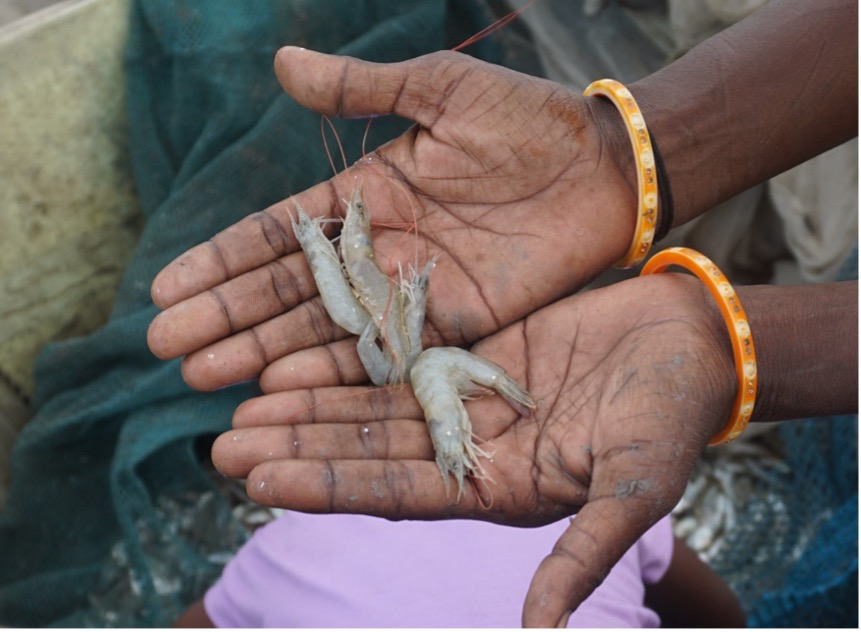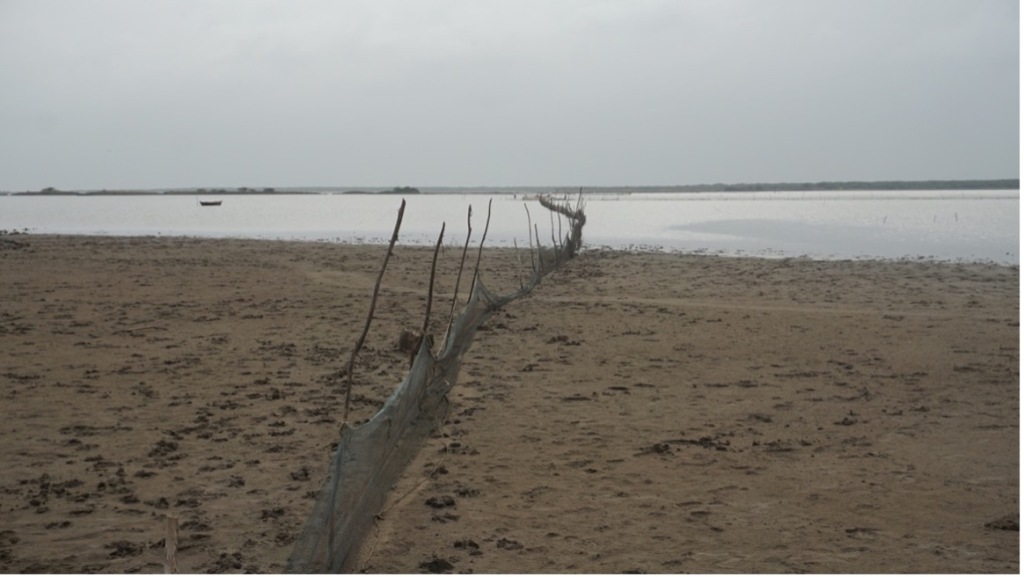By Sita Mamidipudi, University of California, Los Angeles.
Editorial Note: This post is part of our series highlighting the work of the Anthropology and Environment Society’s 2023 Roy A. Rappaport Prize Finalists.
ABSTRACT: I examine emergent conflicts over control of the materiality and flow of water between fishworkers and industrial salt manufacturers in Western India. Saltpans, or ‘Agars’ have been traditionally farmed by Koli Agariyas, a lower-caste group based along the Rann. Agariyas are also called Dus Ekariya (or Ten-Acre Farmers) because the standard size of their leased land is 10 acres. Over the past decade, Agariyas are being supplanted as the primary producers of salt in this region. In their place, industrial salt manufacturers have been legally and illegally taking over large swathes of land, 500 to 9000 acres in size, to convert them into large-scale salt factories. To ensure year-round production of salt, these manufacturers build embankments that are 8-15 feet in height and width. These embankments block intertidal flows, rivers and creeks, preventing seasonal inundation in parts of the Rann, marine life from entering the estuarine space, and fishworkers from their livelihoods. I argue that the standoff between fishworkers and commercial salt- manufacturers reveals the contentious and laborious practices of maintenance and care embedded within unstable and amphibious places where lines between water and land are blurry.
One early July morning in 2023, two days before a new moon, I helped Yasmin pull her husband’s boat onto the shore after a long night of prawn harvesting. I was only a few steps behind her, but by the time I reached the boat with her, she had started frantically rummaging through the buckets full of fish to look for prawns. A few minutes later, she had only found three prawns in the whole boat. This close to the new moon, the boat should have been overflowing with prawns, Yasmin tells me, dejected. “Here, take a picture. Show everyone.”

Yasmin and her family are fishworkers and prawn harvesters from the Muslim Miyana community who live by the Little Rann of Kutch in Western India. This region is a low-lying ecotone over 4900 sq. kms in size, inundated by the sea during the four months of the monsoon and a saline desert for the rest of the year. During the monsoon, Miyana fishworkers and their families live in temporary settlements for as long as the desert is inundated to harvest prawns. These settlements are located at ‘kaantthas’ – sea-banks or edges of the desert when it is inundated by the sea. Once the monsoon ends, they return to their villages giving way to artisanal salt manufacturers at these same kaantthas. This seasonal and cyclical shift between marine and terrestrial, inundation and recession, prawn harvesting and salt manufacturing, Miyana and Koli settlement, is the most defining character of the Little Rann of Kutch.
Prawn harvesting, the main source of livelihood for thousands of Muslim Miyana fishworkers in the region, depends on the species Metapenaeus kutchensis or ‘ginger prawns’ – red or pink in color as adults, and grey and muddy as juveniles. Adults of the species are known to mate just before the monsoon, after which postlarvae and juvenile prawns enter the Rann which acts as a nursery ground. Seawater by itself is too salty for some species of prawns, fish, and other forms of marine life to reproduce and grow. The monsoon, in flooding the Rann and connecting it to the Arabian sea, opens up an estuarine space and offers an opportunity for these species to escape into waters that are not so harsh. Juvenile prawns enter the Little Rann during the full moon, and mature in the two weeks between the full and the new moon. Fishworkers set up bag-nets in the Rann during the waning of the moon to catch mature prawns as they swim back out towards the sea – the closer to the new moon, the plumper, juicier and tastier the prawns are. But in the monsoon in 2023, as in the few years before that, fishworkers have been having very little luck.
The Little Rann fills with water during the monsoon through many sources including water from the rivers that flow into the Arabian sea through the Gulf of Kutch, rainwater, runoff agricultural water, and tidal waters from the Arabian sea which enter through a network of creeks. This mixture of sea, river, runoff and rainwater in the Rann while it is inundated is called bhambra pani. Any small shift in water – whether in the quantity of rain, flows of tidal water, direction and force of winds, pressure of river water, number of canals from dams, composition of agricultural runoff water – affects prawn harvesting in the Rann. These shifts determine how successful the prawn season is, or could leave boats like Yasmin’s empty, causing the difference between starvation and financial stability in any given year. Over the past decade, each of these waters has become uncertain through a deadly combination of climate change, erratic and unpredictable rainfall, infrastructural intrusions and neoliberal capital.

In this paper, I examine emergent conflicts over control of the materiality and flow of water between fishworkers and industrial salt manufacturers in the region. Saltpans, or ‘Agars’ have been traditionally farmed by Koli Agariyas, a lower-caste group based along the Rann. Agariyas are also called Dus Ekariya (or Ten-Acre Farmers) because the standard size of their leased land is 10 acres. Over the past decade, Agariyas are being supplanted as the primary producers of salt in this region. In their place, industrial salt manufacturers have been legally and illegally taking over large swathes of land, 500 to 9000 acres in size, to convert them into large-scale salt factories. To ensure year-round production of salt, these manufacturers build embankments that are 8-15 feet in height and width. These embankments block intertidal flows, rivers and creeks, preventing seasonal inundation in parts of the Rann, marine life from entering the estuarine space, and fishworkers from their livelihoods.
While other ethnographers have focused on how land and water emerge as discrete categories through legal and technological interventions by which flows of water are managed and manipulated (Lahiri-Dutt and Samanta 2011, Bhattacharyya 2018, Gaynor 2020), I speculate that in Nagawadi kaanttha, land and water being indiscrete yet political categories actually facilitates unequal contestations over the flows of seawater, rainwater, groundwater and riverwater – whether through the material and size of embankments for commercial saltpans, or by destroying mangroves, waterways and forms of marine life.
References
Lahiri-Dutt, Kuntala, and Gopa Samanta. 2013. Dancing with the River: People and Life on the Chars of South Asia.
Bhattacharyya, Debjani. 2018. Empire and Ecology in the Bengal Delta : The Making of Calcutta. Cambridge, United Kingdom ; Cambridge University Press,. Gaynor, Jennifer. 2020. ‘Liquid Territory, Shifting Sands: Property, Sovereignty, and Space in Southeast Asia’s Tristate Maritime Boundary Zone’. in Blue legalities: the life & laws of the sea, edited by I. Braverman and E. R. Johnson. Durham: Duke University Press.